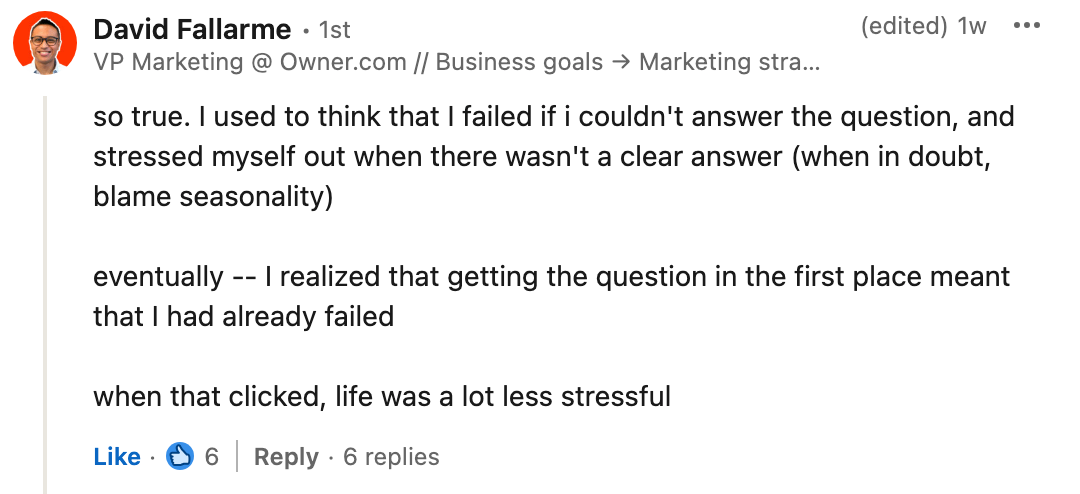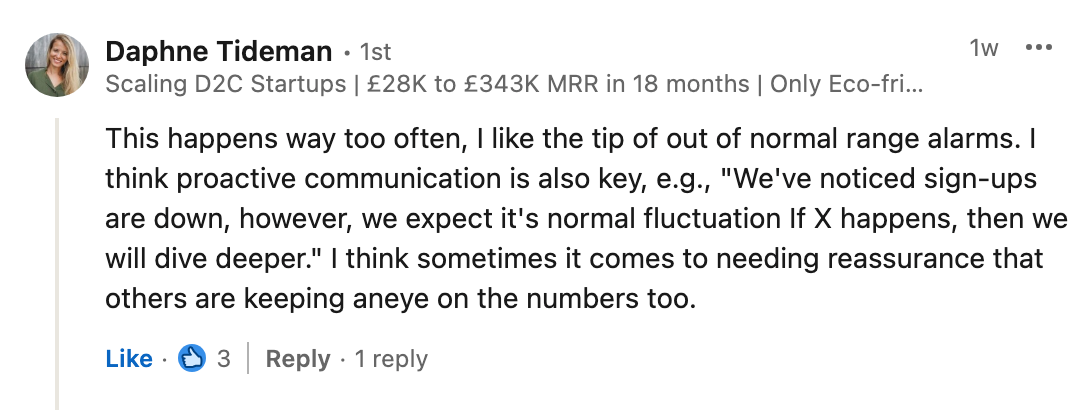The KPI Trap: How to Spot the Dips That Actually Matter
And the 4-step playbook to stop wasting hours chasing false alarms
It starts with a Slack ping, “Hey can you check this out?”
And just like that, you’re staring at the dashboard, trying to detangle what caused a 5% dip last week.
You know it’s probably nothing. But the C-Suite is already asking questions. And just in case there’s a real problem, you’d rather be the one who finds it - than someone who gets told about it later.
So you dig in.
You open five tabs, cross-check user flows, pull a fresh Looker or MixPanel report.
Two hours later, you still have no idea why. You find yourself counting the number of weekdays in a month, and researching random holidays in other countries. Meanwhile, the work that actually moves the needle is still sitting in your to-do list. Chasing harmless dips feels productive, but it’s a distraction disguised as urgency.
I’ve been through this cycle more times than I’d like to admit.
The real work is learning how to ignore the noise and building a system that gives you permission to stay focused.
Here’s how to do that.
Why that Slack message derails your day (and how to tell if it’s just noise)
Your day gets derailed by five innocent words: “Can you look into this?”
At first glance, it’s a totally reasonable ask. If you’re accountable for a metric, you should probably know why it’s changed. But it instantly flips your mindset from proactive to reactive, and suddenly your focus is gone.
And when you’re leading growth, protecting your focus is everything.
That tiny ask launches a full-blown investigation. You jump into dashboards. You check five different tools. You cross-reference channel data, behavioral data, user flows - looking for anything that might explain the blip. Most of the time, there’s nothing there.
This has happened more times than I can count. Where I’ve spent hours investigating movement in a metric, didn’t find a cause, and it returned to normal a week or so later.
I once was asked to investigate a dip in our high-value signups.
I pulled data from Mixpanel. Checked GA. Dug through paid campaign data. Looked at our landing page performance - and traffic to our shopper pages. Then sat shoulder-to-shoulder with the BI team and marketing ops for hours. Our best guess? There was an international holiday.
It was a full day of work… that led nowhere.
And a week later, the number bounced back on its own.
But our brains don’t like uncertainty. So when someone senior flags a concern, the emotional loop kicks in: What if I miss something important? What if this is the one time it actually matters? So we drop everything. We dig. We over-analyze. We stress.
It’s rarely worth it.
I posted about this on Linkedin and learned that David had been through the same runaround.
Reacting to normal variance trains you, and your team, to chase noise... instead of focusing on what actually drives growth.
Most dips don’t need your attention.
What you need is a system that helps you ignore the ones that don’t matter.
The hidden cost of chasing false alarms
When you work on a growth team, exploring the data feels like important work. And many times, it is!
But, false urgency is expensive.
It burns hours that could be spent on more strategic priorities. It pulls your team into busywork that produces no new insight. And when you train your brain to chase every blip, you start making decisions from fear, not from strength.
When you're not babysitting metrics, you can actually dig into the work that drives compounding results: running experiments, coaching your team, aligning with product, talking to users. That's what creates leverage.
And over time, that compounds.
You become someone who responds to problems, instead of someone who drives outcomes. So if your day ends and you feel like you were busy, but not effective, this might be why.
Not every dip deserves your attention.
And chasing every one of them makes it harder to see what actually matters.
How to spot the 1% of dips that actually matter
You don’t need to catch every dip, just the right ones.
Most fluctuations are exactly that. But if you’re responsible for growth, you can’t afford to miss the signals that do matter. So the goal isn’t to track everything, it’s to build guardrails that surface only the outliers.
That means setting baselines for normal performance.
Understanding the normal range for signups, activation rate, trial-to-paid conversions, upgrades, churn, and whatever else you’re responsible for. Get clear on what healthy looks like, so you can quickly spot when something falls outside of it.
I like to set thresholds that trigger automated alerts, when a KPI falls outside of the standard deviation for more than a day or two.
As Joseph pointed out:
Simple guardrails like this keep you from reacting to every wobble.
So you don’t need to babysit the dashboard, or rely on gut feel. The right thresholds catch real issues before they snowball. They protect your focus by filtering out the random noise.
When you combine that with regular check-ins and a clear metric hierarchy, you start to manage by signal, not by Slack ping.
It’s about creating structure so you can act when it actually matters.
As Daphne pointed out:
That’s why proactive updates matter. A quick “this is normal unless X happens” can quiet the panic before it starts.
The 4-Step playbook that stops the panic before it starts
If you’re getting pinged about a small KPI dip, it means your system failed before you did.
It’s not just about the number dipping. It’s about the team wondering if anyone’s paying attention already.
Here’s the playbook I use to stay ahead:
1. Educate the c-suite on what matters
Clarify which KPIs deserve attention, and how often those numbers should be reviewed. When everyone knows what “normal” looks like, it’s easier to avoid unnecessary fire drills.
2. Set automated alerts
Build systems that ping you only when a metric drops outside the expected range, like a 10% drop for 2+ consecutive days. No digging unless the data asks for it.
3. Proactively communicate
When something does dip, get ahead of the questions. A quick message like:
“We’ve noticed a drop in X. Looks like a normal fluctuation for now, but if Y happens, we’ll investigate further,” can prevent hours of follow-up and unnecessary stress.
4. Treat Slack pings as a lagging indicator
If you’re getting asked to explain a dip, it means your system, and your communication, aren’t working hard enough yet. That’s your signal to tighten the process.
What this really means: You’re not trusted to know what matters, when it matters. That’s not a metric problem. That’s a leadership signal.
This system will keep you from scrambling every time a number moves.
You don’t earn trust by reacting, you earn it by leading.
You’ve now got a system for protecting your focus, without missing what matters.
And in the process, you’ll stop reacting to every blip… and start leading like a strategic operator.
Here’s a quick recap of what we covered:
Why that Slack message derails your day (and how to tell if it’s just noise)
The hidden cost of chasing false alarms
How to spot the 1% of dips that actually matter
A 4-step playbook that stops the panic before it starts
You don’t have to chase every fluctuation. You just need a system that helps you stay focused on what matters.
Want help building this kind of system?
I coach growth leaders on exactly this. How to lead with clarity, protect your focus, and drive real outcomes - without burning out.
If you’re navigating messy metrics, noisy dashboards, or Slack pings that derail your day, I can help. Learn more about my coaching programs.







